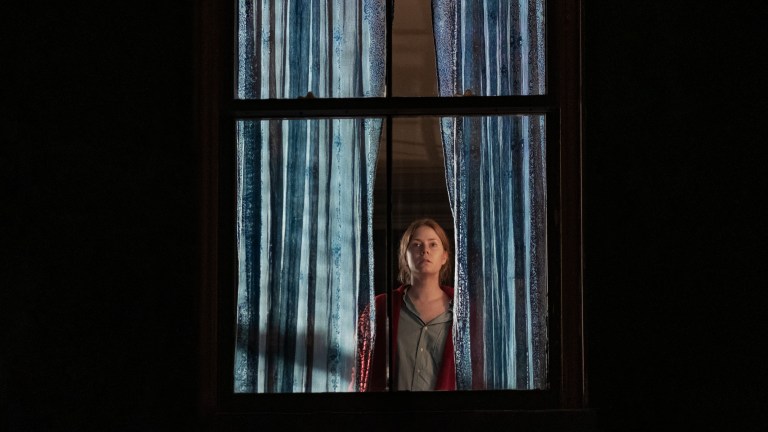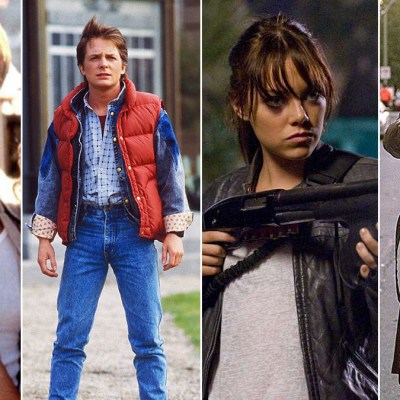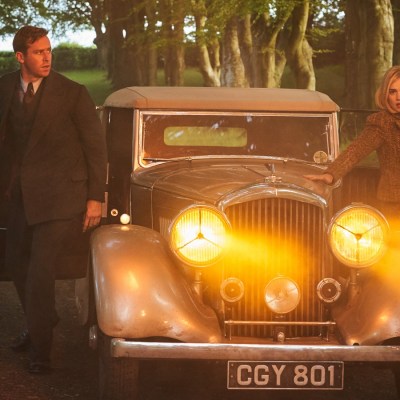Why The Woman in the Window Fails to Channel Alfred Hitchcock
The Woman in the Window clearly wants to be a throwback to Alfred Hitchcock thrillers, mainly Rear Window. But it doesn’t succeed.

This article contains The Woman in the Window spoilers.
Joe Wright’s The Woman in the Window is not shy about its Hitchcockian influence. It’s there in both subtle and overt ways from the very first scene. During one of the film’s opening shots, the camera pans around Amy Adams’ ridiculously spacious New York City brownstone and passes a television screen that is inexplicably playing the ending to Alfred Hitchcock’s Rear Window (1954) in slow-motion, with Jimmy Stewart wrestling against the grip of an out-of-frame Raymond Burr.
With a very similar premise to Rear Window—a slightly deranged New Yorker pries into the hidden lives of her neighbors—The Woman in the Window freely owns up to its influences and aspirations. Sadly, Rear Window, this is not. Which may explain why 20th Century Studios (back when it was called 20th Century Fox) delayed the movie for reshoots, and then Disney ended up selling this otherwise incredibly polished and stylish thriller to the industry’s algorithm farm upstate: Netflix.
Admittedly, The Woman in the Window is not intended to be a direct remake of Rear Window or any other Hitchcock picture. The talent involved is too smart for that. Rather the film is taking a plethora of inspirations from various Hitch joints, and marrying that Master of Suspense ethos with a modern sensibility created by author A. J. Finn, who wrote the novel the film is based on. I have not read the book, but the bestseller clearly benefited from the boom of “grip lit” novels—thrillers often centered around the unreliable perspective of flawed female protagonists—in the 2010s.
So it is that The Woman in the Window’s Dr. Anna Fox (Adams) is an exceedingly troubled individual, suffering from a trauma we only learn late in the story was caused by the tragic death of her husband and child. Those deaths were in turn precipitated by Anna’s own infidelities, which left her distracted while driving on an icy road. Hence the audience is asked to question everything we see in The Woman in the Window, including whether Anna really met the woman she thinks is Jane Russell (Julianne Moore) and if Jane was then actually murdered across the street.
In essence, it’s the same setup of Rear Window where Anna thinks her neighbor (Gary Oldman in the newer movie’s case) murdered his wife, but the accusation is clouded in doubt for even the audience since Anna is such an unreliable narrator that for two-thirds of her movie, she convinces us that she’s going through a divorce instead of grief.
And yet, none of these added elements distract from the fact that this movie wants to be Hitchcock, or at least the heir to what many consider to be his masterpiece. It’s there every time Anna spies on her neighbors through the long lens of her old school camera, which unsubtly harkens back to Stewart’s Jeff doing the same in Rear Window. And it’s woven into the silver mane of hair on Oldman’s head, which intentionally echoes Burr’s sinister everyman who lives in the apartment across from Jeff’s.
Even the film’s opening shot more covertly recalls another Hitchcock classic starring James Stewart: Vertigo (1958). With its slowly spiraling image of snow drops drifting in a circle through the air—an image we later learn is the last thing Anna saw before her family died—we’re retroactively reminded of the spirals that consumed the mind of Stewart’s Scottie in that film. The zoom-in, pullback dolly shot Hitch also made famous in that movie of nerve-inducing stairwells is likewise visually referenced in The Woman in the Window, with the stairwell in Anna’s home recreating the same high anxiety composition as a set of stairs in one of Hitchcock’s earliest films, the silent British production, Blackmail (1929). I’m also fairly convinced that the shot of Adams opening her eye in the second image of The Woman in the Window is a visual recreation of Janet Leigh’s frozen death stare in Psycho (1960).
Right down to its plot about wives causing a case of mistaken identities, the Hitchcockian overtones are heavy in The Woman in the Window. So why doesn’t it work?
For all of Hitchcock’s innovative understanding of the filmmaking craft, and panache for droll showmanship as the “Master of Suspense,” his own passions and fixations (particularly at their most perverse) colored his work with an eerie madness. Or at least the best ones. Sure, he is one of the first directors to make himself a household name via attention-grabbing cameos and almost car dealership-like theatrics in the rollout of new movies’ marketing. And when Tippi Hedren asked him why her character in The Birds (1963) would open a door if there are menacing noises on the other side, he replied, “Because I said so.”
But then, despite its popularity, The Birds is hardly one of Hitchcock’s best films. And the hypnotic effect he created with the better ones often spoke to something truer, and frankly uglier, than the glossy veneer of his star-studded casts. Ironically, this is probably truest about the two Hitch films Woman in the Window most desperately emulates: Rear Window and Vertigo.
In both films, one could sense the devious pleasure Hitchcock took in casting Jimmy Stewart—the all-American face of Frank Capra classics like Mr. Smith Goes to Washington (1939) and It’s a Wonderful Life (1946)—as his on screen avatar.
In the case of Rear Window, Stewart still plays an ostensibly heroic individual. Jeff is a man’s man and a photojournalist who goes into warzones, vacations on safaris, and breaks his leg while covering a high performance car race from a dangerous vantage point. But there is something more unsettling beneath all that machismo which is what won the attention of a much younger high society girl, Lisa (Grace Kelly).
There’s a gnawing suspicion about the awfulness of his fellow man, and a peculiar desire to revel in it. When Jeff can’t do that from behind enemy lines, he’ll settle for studying it in his own backyard—it’s a view he shares with a slew of neighbors overlooking a lower Manhattan courtyard. He doesn’t start spying on them though because he heard a scream and fears for a woman he just met. He does it out of boredom while his leg is bandaged up. Well that, plus a perverse curiosity, be it in the form of lust for the dancer across the way, Miss Torso, or a voyeuristic fascination with the despair of a woman he nicknames Miss Lonelyhearts. That he discovers a man murdered his wife is entirely happenstance.
Only after he seduces Lisa into sharing his obsessions—to the point where she’ll break into the neighbor’s home—does he realize she’s the perfect girl for him. And after she’s been fully indoctrinated, she shares his “ghoulish” disappointment (her word) when they’re falsely made to believe for a moment that Lars Thorwald’s wife is alive and out of town. That of course turns out to be a misdirection. Lars (Burr) is having an affair and has his mistress pose as his dead wife for a train ride.
Mistaken identity becomes even more pivotal in Vertigo, Hitch’s most revealing cinematic manifesto for how he sees himself. In that film, Stewart appears again but as someone who is hardly depicted as an alpha male. The only hero in this story dies at the beginning when Stewart’s Scottie is so crippled by terror that he cannot save himself as he dangles from a rooftop. The police partner who comes back for him to lift him up ends up taking the literal fall.
Afterward, Scottie (like Anna Fox) is seen as damaged goods by himself and everyone who knows him. Particularly in the 1950s, being diagnosed as suffering from acrophobia or any form of mental illness was treated as an inherent form of weakness and a deficiency of character. An onscreen judge spells this out after Scottie again appears to let his vertigo ruin him, causing him to fail to save the woman he thinks is Madeleine Elster (Kim Novak). He can’t find the wherewithal to follow her up a bell tower, and is then treated to the horror of seeing a woman fall to her death outside.
Of course the twist of the movie is that Novak is not playing Madeleine; she’s Judy Barton, the woman whom Madeleine’s husband Gavin (Tom Helmore) has hired to impersonate his wife and seduce Scottie before running up a high stairwell. At the top, Gavin waited to throw his actual wife to her doom. Unfortunately for Judy, Scottie’s broken mind wouldn’t stop looking for her until one day he found the woman he thought he loved still walking the streets of San Francisco.
The Woman in the Window blends these narrative elements. Once again, a protagonist with a phobia (agoraphobia here) mistakes a blonde woman—Julianne Moore’s Katie—for another character’s wife. When Jennifer Jason Leigh barges into Anna’s brownstone, it’s meant to be as bewildering as when Scottie sees Novak still walking around, now as a brunette, in Vertigo. Of course Woman in the Window plays with the convention by making it the biological mother of Oldman and Leigh’s adopted son whom is murdered, as opposed to the actual wife. Indeed, Moore’s Katie just enjoys playing into Anna’s misconception that she’s the wife of Oldman’s Alistair Russell.
But these reliances on miscommunication and unreliable narrators aren’t really in service of anything other than the twist. The thrill, such as it is, amounts to little more than Anna’s epiphany of staring into a photograph and realizing thanks to a reflection that a blonde woman played by Moore really was inside her home. The rug is then even further pulled when it’s revealed that (SURPRISE!) it wasn’t Alistair who murdered Katie, but Katie’s actual biological son, Ethan (Fred Hechinger).
However, the twist is as empty as Anna’s painfully quiet home. It’s intended to be a “gotcha” reveal, but it never really gets under the skin.
By contrast, the idea that Madeleine is really Judy in Vertigo is a gateway to explore Hitchcock’s vices: blondes and the desire to control them. It’s why Stewart’s Scottie becomes as manipulative as an auteur with a fetish, and as possessive of his new paramour as the filmmaker who’s still trying to replace his greatest leading lady collaborator after she’s retired from acting to be the Princess of Monaco. Scottie maniacally remaking Judy into Madeleine, and Jimmy Stewart remaking Kim Novak into Grace Kelly, is some bizarre but intoxicating allegory about Hitchcock and his own self-image of his obsession.
Notably, Vertigo wasn’t a hit in 1958. In fact, it flopped at the box office and was only reevaluated as a masterpiece in the 1980s, after Hitch’s death. It was too weird and, intentionally or not, introspective for the ‘50s. And personally, I still prefer Rear Window for better balancing the director’s eccentricities with his commercial instincts to make a top notch thriller which can be revealing about the darker side of human nature yet still remain addictively entertaining and playful.
Woman in the Window attempts to wear the style of both, but has no controlling idea to add to those affectations other than a subversion of their twists: it’s the son who murders the other woman instead of the husband who kills the wife. The meaninglessness of this mangled reversal is why it feels so cheap when the movie devolves into a slasher flick, with Ethan chasing Anna to the rooftop as if he were attempting to star in “Scream 5” instead of “Rear Window 2.”
The Woman in the Window is a loving impersonation of Hitch, but be it a thriller or a comedy, an impersonation is never going to carry a movie.


